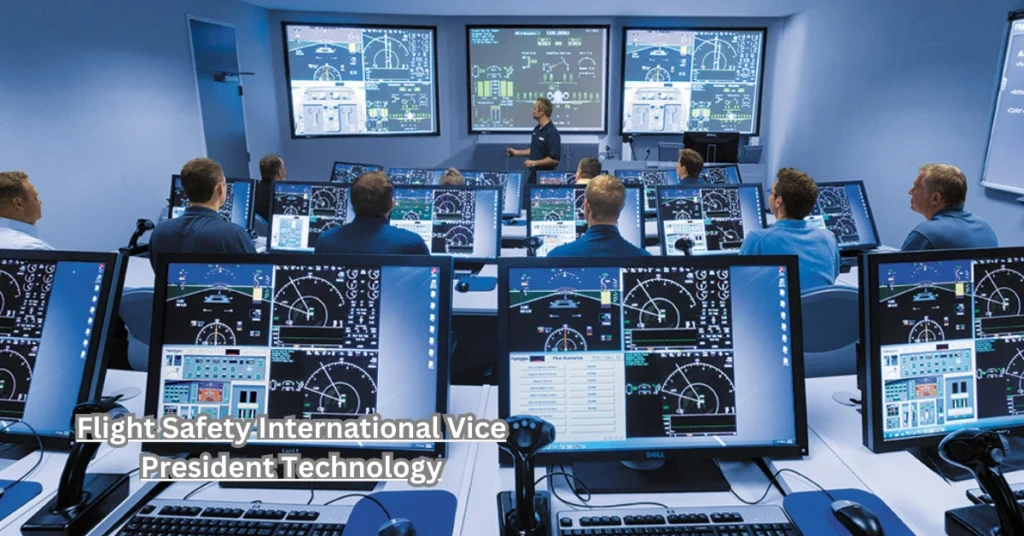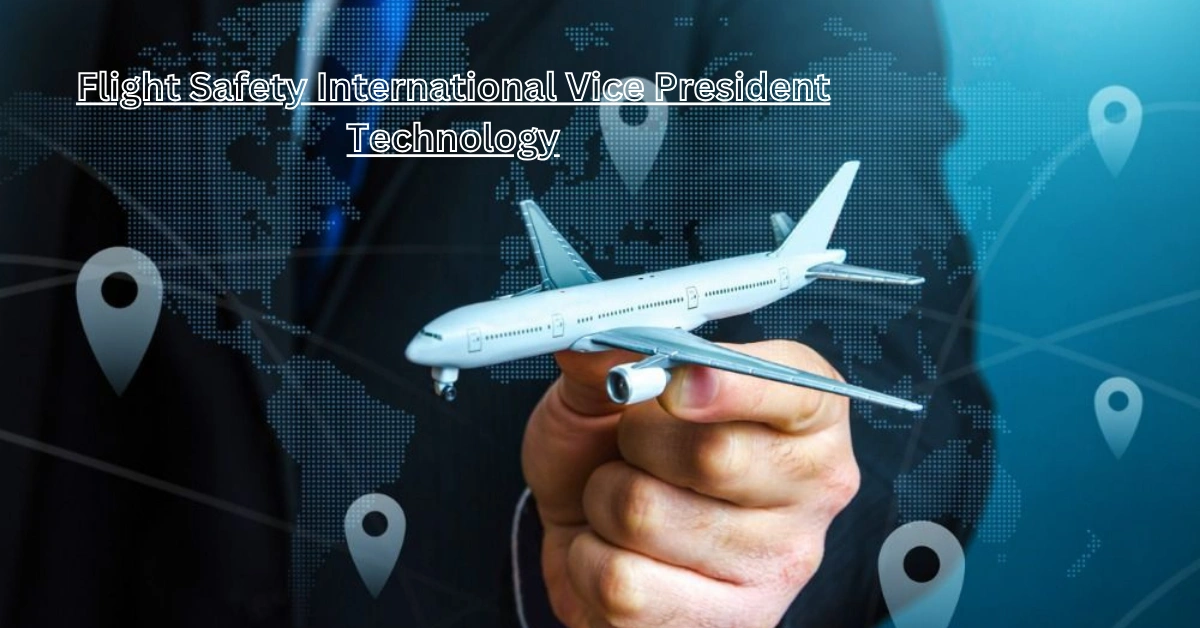The aviation industry is driven by constant innovation, with safety as its foremost priority. At the heart of these technological advancements lies the role of the Flight Safety International Vice President of Technology. This leader is responsible for overseeing the development and integration of cutting-edge technologies that enhance flight safety and operational efficiency. In this article, we will explore how the Vice President of Technology at Flight Safety International (FSI) ensures that air travel remains one of the safest modes of transportation, emphasizing the significance of their expertise in shaping the future of aviation.
Who is the Flight Safety International Vice President Technology?

The Flight Safety International Vice President of Technology is an executive responsible for leading technological advancements that improve aviation safety, efficiency, and training. FSI is a global leader in aviation training and simulation, known for its advanced flight simulators and cutting-edge training programs for pilots and flight crews. The Vice President of Technology plays a pivotal role in overseeing the creation and implementation of new technologies, ensuring that FSI’s products and services remain at the forefront of the industry.
With a deep understanding of aviation, safety regulations, and emerging technologies, the Vice President ensures that every technological solution FSI develops meets the highest safety standards. Their role involves strategic oversight, innovation, and collaboration with experts to shape aviation safety practices.
The Responsibilities of the Flight Safety International Vice President Technology
The Flight Safety International Vice President Technology holds a critical position that influences various facets of the company’s operations. Their responsibilities span several key areas:
1. Driving Technological Innovation in Aviation Safety
The Vice President of Technology is instrumental in advancing flight safety by introducing innovative technologies. These may include enhanced flight simulators, real-time data monitoring systems, and advanced cockpit technologies. By integrating cutting-edge technology, the Vice President of Technology ensures that FSI’s offerings continue to improve safety standards across the aviation industry.
2. Overseeing Research and Development (R&D)
A large part of the Vice President’s role involves overseeing the company’s R&D efforts. FSI’s commitment to innovation is reflected in the development of next-generation flight simulation systems, AI-driven predictive safety systems, and virtual reality (VR) training platforms. Through this R&D, FSI aims to stay ahead of emerging risks and challenges in aviation safety.
3. Ensuring Compliance with Global Safety Standards
As aviation technology continues to evolve, the Flight Safety International Vice President Technology ensures that all technological innovations comply with global safety regulations. They collaborate with aviation regulators, airline companies, and manufacturers to ensure that FSI’s products align with safety requirements and industry best practices.
Key Technologies Shaped by the Flight Safety International Vice President Technology

Technology has become a game-changer in aviation safety, and the Flight Safety International Vice President Technology is at the forefront of this revolution. Here are some of the key technological advancements in aviation safety led by FSI:
1. Flight Simulators for Enhanced Pilot Training
Flight simulators are one of the most effective tools for pilot training, and FSI is renowned for creating some of the most advanced simulation systems in the world. The Vice President of Technology is responsible for pushing the boundaries of what simulators can do, incorporating technologies like AI to make simulations more realistic and immersive. These simulators allow pilots to experience various emergency scenarios, improving their decision-making skills without any risk.
2. Real-Time Aircraft Monitoring Systems
Real-time monitoring systems, led by innovations from the Flight Safety International Vice President Technology, track aircraft health throughout a flight. These systems collect critical data on engine performance, fuel levels, and other vital metrics, helping to predict potential failures and allowing maintenance crews to take proactive action before issues arise.
3. Artificial Intelligence and Predictive Analytics
AI and predictive analytics are transforming aviation safety. The Vice President of Technology is leading the integration of AI into safety systems, using data to predict potential risks, optimize flight paths, and enhance operational efficiency. This use of AI helps to identify patterns in flight data that could signal a safety concern before it escalates.
4. Virtual Reality (VR) Training Systems
Another key technology championed by the Flight Safety International Vice President Technology is the use of Virtual Reality (VR) in training. VR-based training programs provide flight crews with a highly immersive environment where they can practice emergency procedures and flight scenarios that would be difficult to simulate in real life. VR training improves response times and decision-making under pressure, ultimately enhancing flight safety.
Skills and Expertise Required for the Role of Vice President of Technology at Flight Safety International

The Flight Safety International Vice President of Technology holds a role that demands a combination of technical expertise and leadership skills. Some of the essential qualifications for this position include:
- Deep Knowledge of Aviation Safety: A strong understanding of flight safety protocols and industry regulations is crucial for guiding technological innovations that align with global safety standards.
- Leadership and Strategic Thinking: The Vice President of Technology must lead teams of engineers, developers, and researchers, providing strategic oversight to ensure the successful integration of new technologies.
- Technical Expertise: Profound knowledge of emerging technologies like artificial intelligence, machine learning, data analytics, and flight simulation systems.
- Collaboration and Communication: The role requires effective collaboration with internal teams, external partners, aviation regulators, and industry stakeholders to ensure alignment with safety standards.
- Problem-Solving and Innovation: The Vice President must continuously assess challenges in aviation safety and develop innovative technological solutions to address these issues.
The Future of Aviation Safety and the Role of the Flight Safety International Vice President Technology
The future of aviation safety is undeniably intertwined with technology. As the Flight Safety International Vice President Technology continues to drive advancements in AI, data analytics, and simulation technologies, we can expect even greater strides in improving safety, reducing human error, and enhancing operational efficiency.
From predictive maintenance systems to next-gen flight simulators, the role of the Vice President Technology will continue to be central to ensuring air travel remains one of the safest modes of transportation.
Conclusion
The Flight Safety International Vice President Technology plays an indispensable role in driving innovation and ensuring safety in the aviation industry. Through their leadership and expertise, FSI has been able to develop groundbreaking technologies that enhance flight training, improve operational safety, and help prevent accidents. As the aviation industry continues to evolve, the role of the Vice President of Technology will remain pivotal in shaping the future of aviation safety.
FAQ: Flight Safety International Vice President Technology
1. What is the role of the Flight Safety International Vice President Technology?
The Flight Safety International Vice President Technology leads the development and integration of advanced technologies to improve flight safety. This includes overseeing R&D efforts, managing innovations like flight simulators and AI, and ensuring compliance with safety regulations.
2. How does the Flight Safety International Vice President Technology enhance aviation safety?
The Vice President Technology enhances aviation safety by introducing cutting-edge technologies such as real-time aircraft monitoring, AI-driven predictive systems, and virtual reality-based training solutions that help pilots and crews respond effectively in emergency situations.
3. Why is technology important in flight safety?
Technology improves flight safety by reducing human error, enhancing training, and providing real-time monitoring systems that predict and prevent potential safety issues before they occur. Innovations like AI, predictive analytics, and flight simulators are central to modern flight safety practices.
Discover the 2024 Ford Escape Platinum – Learn more about its premium technology package here.
